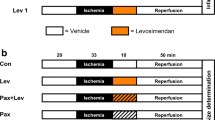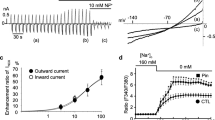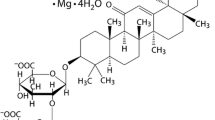Abstract
During heart ischemia, ATP-sensitive potassium channels in the sarcolemmal membrane (sarcKATP) open and cause shortening of the action potential duration. This creates heterogeneity of repolarization, being responsible for the development of re-entry arrhythmias and sudden cardiac death. Therefore, the aim is to develop selective blockers of the cardiac sarcKATP channel. In the present study we established an in vitro model and classified 5 KATP channel inhibitors with respect to their potency and selectivity between cardiomyocytes and the coronary vasculature and compared the results with inhibition of Kir6.2/SUR2A channels expressed in HEK293 cells, recorded with the Rb+-efflux methods. We used Langendorff-perfused guinea pig hearts, where low-flow ischemia plus hypoxia was performed by reducing the coronary flow (CF) to 1.2 ml/min and by gassing the perfusion solution with N2 instead of O2. Throughout the experiment, the monophasic action potential duration at 90% repolarization (MAPD90) was recorded. In separate experiments, high-flow hypoxia was produced by oxygen reduction in the perfusate from 95% to 20%, which caused an increase in the coronary flow. Under normoxic conditions, the substances glibenclamide, repaglinide, meglitinide, HMR 1402 and HMR 1098 (1 μM each) reduced the CF by 34%, 38%, 19%, 12% and 5%, respectively. The hypoxia-induced increase in CF was inhibited by the compounds half-maximally at 25 nM, approximately 200 nM, 600 nM, approximately 9 μM and >100 μM, respectively. In control experiments after 5 min low-flow ischemia plus hypoxia, the MAPD90 shortened from 121±2 to 99±2 ms (n=29). This shortening was half-maximally inhibited by the substances at concentrations of 95 nM, 74 nM, 400 nM, 110 nM and 550 nM, respectively. In HEK293 cells the Rb+-efflux through KIR6.2/SUR2A channels was inhibited by the compounds with IC50 values of 21 nM, 67 nM, 205 nM, 60 nM and 181 nM, respectively. In summary, the present data demonstrate that the sulfonylurea glibenclamide, and the carbamoylbenzoic acid derivatives repaglinide and meglitinide are unselective blockers of KATP channels in cardiac cells and in the cardiac vascular system, whereas the sulfonylthioureas HMR 1402, and especially HMR 1098 selectively blocked the cardiac sarcKATP channel. Blockade of Kir6.2/SUR2A channels in HEK293 cells occurred with comparable efficacy as in the cardiac tissue, indicating that the expression system is suited for screening for novel inhibitors.







Similar content being viewed by others
References
Benndorf K, Bollmann G, Friedrich M, Hirche H (1992) Anoxia induces time-independent K+ current through KATP channels in isolated heart cells of the guinea-pig. J Physiol (Lond) 454:339–357
Billman GE (1994) Role of ATP sensitive potassium channel in extracellular potassium accumulation and cardiac arrhythmias during myocardial ischaemia. Cardiovasc Res 28:762–769
Billman GE, Avendano CE, Halliwill JR, Burroughs JM (1993) The effects of the ATP-dependent potassium channel antagonist, glyburide, on coronary blood flow and susceptibility to ventricular fibrillation in unanesthetized dogs. J Cardiovasc Pharmacol 21:197–204
Billman GE, Englert HC, Schölkens BA (1998) HMR 1883, a novel cardioselective inhibitor of the ATP-sensitive potassium channel. II. Effects on susceptibility to ventricular fibrillation induced by myocardial ischemia in conscious dogs. J Pharmacol Exp Ther 286:1465–1473
Billman GE, Houle MS, Englert HC, Gögelein H (2004) The effect of a novel cardioselective ATP-sensitive potassium channel antagonist, HMR 1402, on susceptibility to ventricular fibrillation induced by myocardial ischemia: in vitro and in vivo studies. J Pharmacol Exp Ther (in press)
Cyrys S, Daut J (1994) The sensitivity of coronary vascular tone to glibenclamide: a study on the isolated perfused guinea pig heart. Cardiovasc Res 28:888–893
Dabrowski M, Wahl P, Holmes WE, Ashcroft FM (2001) Effect of repaglinide on cloned beta cell, cardiac and smooth muscle types of ATP-sensitive potassium channels. Diabetologia 44:747–756
Daut J, Maier-Rudolph W, Von Beckenrath N, Mehrke G, Günther K, Goedel-Meinen L (1990) Hypoxic dilation of coronary arteries is mediated by ATP-sensitive potassium channels. Science 247:1341–1344
Decking UKM, Reffelmann T, Schrader J, Kammermeier H (1995) Hypoxia-induced activation of KATP channels limits energy depletion in the guinea pig heart. Am J Physiol Heart Circ Physiol 269:H734–H742
Dhein S, Pejman P, Krüsemann K (2000) Effects of the IKATP blockers glibenclamide and HMR1883 on cardiac electrophysiology during ischemia and reperfusion. Eur J Pharmacol 398:273–284
Duncker DJ, Van Zon NS, Altman JD, Pavek TJ, Bache RJ (1993) Role of K+ ATP channels in coronary vasodilation during exercise. Circulation 88:1245–1253
Englert HC, Gerlach U, Goegelein H, Hartung J, Heitsch H, Mania D, Scheidler S (2001) Cardioselective KATP channel blockers derived from a new series of m-anisamidoethylbenzenesulfonylthioureas. J Med Chem 44:1085–1098
Findlay I (1992) Inhibition of ATP-sensitive K+ channels in cardiac muscle by the sulphonylurea drug glibenclamide. J Pharmacol Exp Ther 261:540–545
Findlay I (1993) Sulphonylurea drugs no longer inhibit ATP-sensitive K+ channels during metabolic stress in cardiac muscle. J Pharmcol Exp Ther 266:456–467
Giblin JP, Leaney JL, Tinker A (1999) The molecular assembly of ATP-sensitive potassium channels. Determinants on the pore forming subunit. J Biol Chem 274:22652–22659
Gögelein H (2001) Inhibition of cardiac ATP-dependent potassium channels by sulfonylurea drugs. Curr Opin Invest Drugs 2:72–80
Gögelein H, Hartung J, Englert HC, Schölkens BA (1998) HMR 1883, a novel cardioselective inhibitor of the ATP-sensitive potassium channel. I. Effects on cardiomyocytes, coronary flow and pancreatic β-cells. J Pharmacol Exp Ther 286:1453–1464
Gögelein H, Englert HC, Kotzan A, Hack R, Lehr KH, Seiz W, Becker RHA, Sultan E, Schölkens BA, Busch AE (2000) HMR 1098: an inhibitor of cardiac ATP-sensitive potassium channels. Cardiovasc Drug Rev 18:157–174
Gribble FM, Tucker SJ, Seino S, Ashcroft FM (1998) Tissue specificity of sulfonylureas. Studies on cloned cardiac and β-cell KATP channels. Diabetes 47:1412–1418
Imamura Y, Tomoike H, Narishige T, Takahashi T, Kasuya H, Takeshita A (1992) Glibenclamide decreases basal coronary blood flow in anesthetized dogs. Am J Physiol 263:H399–H404
Isomoto S, Kondo C, Yamada M, Matsumoto T, Higashiguchi O, Horio Y, Matzuzawa Y, Kurachi Y (1996) A novel sulfonylurea receptor forms with BIR (Kir6.2) a smooth muscle type ATP-sensitive K+ channel. J Biol Chem 271:24321–24324
Janse MJ, Wit AL (1989) Electrophysiological mechanisms of ventricular arrhythmias resulting from myocardial ischemia and infarction. Physiol Rev 69:1049–1169
Krause E, Englert H, Gögelein H (1995) Adenosine triphosphate-dependent K currents activated by metabolic inhibition in rat ventricular myocytes differ from those elicited by the channel opener rilmakalim. Pflügers Arch 429:625–635
Manning Fox JE, Kanji HD, French RJ, Light PE (2002) Cardioselectivity of the sulphonylurea HMR 1098: studies on native and recombinant cardiac and pancreatic K(ATP) channels. Br J Pharmacol 135:480–488
Mori H, Chujo M, Tanaka E, Yamakawa A, Shinozaki Y, Mohamed M-U, Nakazawa H (1995) Modulation of adrenergic coronary vasoconstriction via ATP-sensitive potassium channel. Am J Physiol Heart Circ Physiol 268:H1077–H1085
Nakhostine N, Lamontagne D (1994) Contribution of prostaglandins in hypoxia-induced vasodilatation in isolated rabbit hearts. Relation to adenosine and KATP channels. Pflügers Arch 428:526–532
Randall MD (1995) The involvement of ATP-sensitive potassium channels and adenosine in the regulation of coronary flow in the isolated perfused rat heart. Br J Pharmacol 116:3068–3074
Rioufol G, Ovize M, Loufoua J, Pop C, André-Fouët X, Minaire Y (1997) Ventricular fibrillation in preconditioning pig hearts: role of K+ ATP channels. Am J Physiol 273:H2804–H2810
Russ U, Hambrock A, Artunc F, Löffler-Walz C, Horio Y, Kurachi Y, Quast U (1999) Coexpression with the inward rectifier K+ channel Kir6.1 increases the affinity of the vascular sulfonylurea receptor SUR2B for glibenclamide. Mol Pharmacol 56:955–961
Russ U, Lange U, Löffler-Walz C, Hambrock A, Quast U (2001) Interaction of the sulfonylthiourea HMR 1833 with sulfonylurea receptors and recombinant ATP-sensitive K+ channels: comparison with glibenclamide. J Pharmacol Exp Ther 299:1049–1055
Samaha FF, Heineman FW, Ince C, Fleming J, Balaban RS (1992) ATP-sensitive potassium channel is essential to maintain basal coronary vascular tone in vivo. Am J Physiol 262:C1220–C1227
Schulz R, Rose J, Heusch G (1994) Involvement of activation of ATP-dependent potassium channels in ischemic preconditioning in swine. Am J Physiol Heart Circ Physiol 267:H1341–H1352
Thierfelder S, Doepner B, Gebhardt C, Hirche H, Benndorf K (1994) ATP-sensitive K+ channels in heart muscle cells first open and subsequently close at maintained anoxia. FEBS Lett 351:365–369
Wilde AAM, Escande D, Schumacher CA, Thuringer D, Mestre M, Fiolet JWM, Janse MJ (1990) Potassium accumulation in the globally ischemic mammalian heart. Circ Res 67:835–843
Wirth KJ, Rosenstein B, Uhde J, Englert HC, Busch AE, Schölkens BA (1999) ATP-sensitive potassium channel blocker HMR 1883 reduces mortality and ischemia-associated electrocardiographic changes in pigs with coronary occlusion. J Pharmacol Exp Ther 291:474–481
Wirth KJ, Uhde J, Rosenstein B, Englert HC, Gögelein H, Schölkens BA, Busch AE (2000) KATP channel blocker HMR 1883 reduces monophasic action potential shortening during coronary ischemia in anesthetised pigs. Naunyn-Schmiedebergs Arch Pharmacol 361:155–160
Wolk R, Cobbe SM, Kane KA, Hicks MN (1999) Relevance of inter- and intraventricular electrical dispersion to arrhythmogenesis in normal and ischaemic rabbit myocardium: a study with cromakalim, 5-hydroxydecanoate and glibenclamide. J Cardiovasc Pharmacol 33:323–334
Author information
Authors and Affiliations
Corresponding author
Rights and permissions
About this article
Cite this article
Weyermann, A., Vollert, H., Busch, A.E. et al. Inhibitors of ATP-sensitive potassium channels in guinea pig isolated ischemic hearts. Naunyn-Schmiedeberg's Arch Pharmacol 369, 374–381 (2004). https://doi.org/10.1007/s00210-004-0882-0
Received:
Accepted:
Published:
Issue Date:
DOI: https://doi.org/10.1007/s00210-004-0882-0




